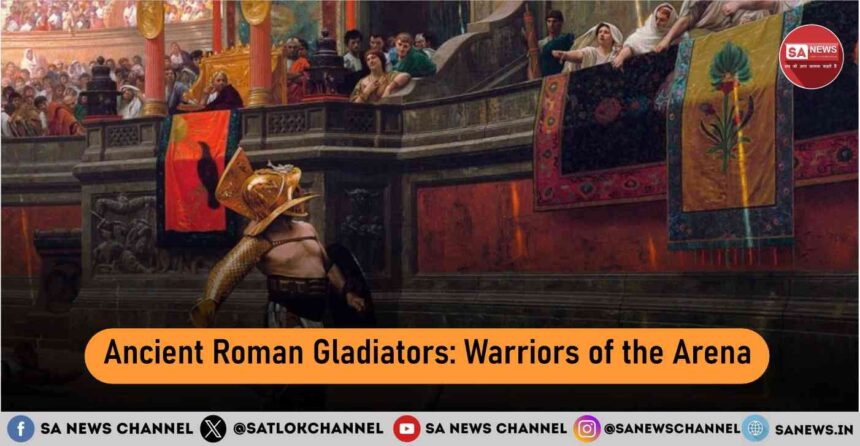The Roman gladiators represent courage, violence, and spectacle in the history of ancient Rome. Emerging from the ancient traditions, the combats of the gladiator brave the pulse of Roman entertainment. These warriors fought for honor, glory and occasionally freedom.
- Origins: Where and How It Began?
- Roman Gladiators: Warriors of Ancient Rome
- Types of Roman Gladiators
- Life and Training in Gladiator Schools
- The Colosseum: Arena of Blood
- Famous Gladiators: Legends and Icons
- Weapons of Roman Gladiators
- Freedom or Death: The Gladiator’s Fate
- Women in the Arena: Female Gladiators
- The End of an Era: Decline and Legacy
- Death is in the hands of kaal
The fights of the Gladiators in the big arenas such as the Colosseum fascinated thousands—combining violence, art, and drama into mythical public spectacles. This blog goes into great depth on the origins, lives, training, and legacy of these warriors who made combat an art form and left a permanent footprint in the cultural and historical landscape of Rome.
Origins: Where and How It Began?
The History of Gladiators does not have fixed roots. Some historians believe that the custom came from the Etruscans or from the funeral contests in Campania. Gladiator combats were a part of Etruscan funeral rites, where combatants’ fights were organised in honor of the dead. The purpose of these fights was sacred and sacrificial.
The first recorded Roman gladiator combat took place at the funeral of Brutus in Rome in 264 BCE. The initial games featured three pairs of gladiators who fought to the death. Over time, these funerary contests evolved into public performances where combatants from various backgrounds, including prisoners of wars, slaves, and later free volunteers fought. These public performances, known as munera, turned into a tool for emperors and aristocrats to gain political favour by showcasing their wealth and power.
Roman Gladiators: Warriors of Ancient Rome
Gladiators had diverse backgrounds. Some were slaves, others criminals, prisoners of war or even free men volunteers who fought for fame or fortune. Roman Gladiators were professional fighters who fought for the entertainment of the masses in Rome, often to the death. Many successful gladiators could become celebrities and earn money, fame, fortune, and sometimes freedom.
Types of Roman Gladiators
The Roman Gladiators are categorised on the basis of their unique fighting techniques and distinct armors and weaponry. Some of the most famous types are:
Heavily Armed
- Samnite: These were one of the earliest gladiators equipped with shield (scutum), sword (gladius), helmet, and often a greave.
- Murmillo: These gladiators wore a large rectangular shield (scutum) and a short sword (gladius). They were recognizable by a helmet with a fish-shaped crest.
- Hoplomachus: These Greek style gladiators wore a plumed helmet. They also carried a spear, a small round shield and a short sword.
- Secutor: These mainly fought against the Retiarus. They wore a smooth, round helmet with small eye holes on it. They also carried a large shield and a short sword.
- Provocator: These gladiators wore a breastplate (pectorale), helmet with plume, and an arm guard. They also carried a large rectangular shield along with a gladius.
Lightly Armed / Agile
- Retiarius: Often fought against the Secutor, these gladiators were only armed with a weighted fishing net, trident, a dagger and only a padded shoulder guard on one arm.
- Thracian (Thraex): These gladiators carried a curved sword (sica) and a small, often square or round shield (parmula).
- Dimachaerus: These were skilled fighters who only used two swords, one in each hand to fight with the opponent.
- Laquearius: These gladiators were similar to Retiarus but used also instead of a net.
Unique and Specialised
- Sagittarius: These gladiators fought on horseback and used bows and arrows.
- Essedarius: These used a style brought from Britain. They used to fight from the chariots.
- Equites: These gladiators like Sagittarius, also fought from horseback and used spears and a gladius, and wore a full tunic.
- Bestarius: These fought against the wild animals.
- Andabatae: They fought blindfolded wearing helmets without eyeholes.
Life and Training in Gladiator Schools
The gladiators were trained in special schools called ludi (singular ludus). These schools provided a structured and disciplined environment aimed to provide rigorous training and a well balanced routine for the gladiators , to prepare gladiators’ body and mind for combat.
The day in ludus started with meals followed by training. The training began with using wooden weapons and also fighting a post called the palus to enhance the combat styles and techniques of the gladiators. They lived in barrack like conditions, but were provided good food and proper hygienic conditions. They were restricted to school grounds until rented out to fight in the arena.
The Colosseum: Arena of Blood
In ancient Rome, the Colosseum served as the grand stage where gladiators displayed their skill and courage. After completing their training in a ludus, gladiators entered the arena through the Gate of Life or the Gate of Death, depending on their fate.
Also Read: Korea’s Forgotten War: How a Nation Split Changed the World
Within the Colosseum’s towering seating and vast sands, these gladiators fought for their lives before thousands of spectators, their contests mixing deadly combat with theatrical display. The gladiator combats were a sign of imperial power and a source of entertainment for the ancient Romans. The Colosseum was the arena that magnified the fame—or sealed the doom—of the gladiators.
Famous Gladiators: Legends and Icons
Some gladiators held the status of celebrities in Ancient Rome. They were iconic either in their combat techniques , cultural impact, or rebellion leadership in Rome. Some of the most famous Roman gladiators are:
- Spartacus: Originally a Thracian Soldier enslaved and forced into gladiator combats, Spartacus was the most famous gladiator in ancient Rome. He also led a slave rebellion against Rome.
- Commodus: A Roman Emperor who himself fought as a gladiator, often rigging matches for his own advantage.
- Flamma: A renowned and passionate Syrian gladiator who refused freedom multiple times in order to continue fighting in the arena.
- Priscus and Verus: Prominent for the legendary duel during the opening of Colosseum. Both of these fighters fought honourably and were both granted freedom.
- Marcus Attilius: Entered the arena to pay off his debts. He won many combats and gained fame as a skilled fighter.
- Spiculus: Emperor Nero’s favorite gladiator who was gifted land and wealth by the Emperor. Nero was so fond of Spiculus, that he called him in his final moments.
- Crixus: A renowned Gaulish gladiator who along with Soartacus, escaped captivity and played an important role in the slave rebellion.
- Carpophorus: A highly – celebrated bestiarius (wild animal fighter) who fought against wild beasts including lions, bears , rhinoceros exhibiting his extraordinary strength against nature’s fiercest animals.
Weapons of Roman Gladiators
The ancient Roman gladiators used a variety of weapons, depending on their fighting styles and armor. Some them are:
- Gladius: This was a short sword used by many gladiator types, especially for close range. It was a double edged, medium length blade, particularly designed for thrusting and immediate and decisive strikes.
- Scutum and spear- based arms: This large rectangular shield (scutum) was used in combination with the gladius to deliver powerful stabs and cuts. The shield protected against the strikes of the lighter opponents.
- Trident and net: Used by the Retiarius gladiator, the three-pronged trident was employed to deliver a fatal strike to an opponent after ensnaring them with a net.
- Cestus: This gladiator boxing glove was worn on the hands or in the forearms sometimes, often with metals or spikes. This increased the punching power and caused severe injury.
- Pugio: A small dagger which was used as the secondary weapon, or even for the close-quarter stabs in the case of blocking or breaking of the primary weapon.
- Hasta and Spear versions: Used by some gladiators for thrusting, especially during contests testing reach and timing.
Freedom or Death: The Gladiator’s Fate
The life and death of the gladiators’ was not scripted but was largely dependent on the skill, surrender, mercy, and the editor’s or the emperor’s judgements which was in turn shaped by the audience’s expectations as a public spectacle. Death was not the only option after every defeat- some fights did end with mercy or the display of skill, while few also ended after the death of the loser as a source of entertainment. It was the Emperor’s final judgement, which was always also shaped by several factors, that decided the fate of the gladiator.
After successful fights, some gladiators also win freedom, fortune, fame and sometimes the status of a celebrity in ancient Rome. Thus, the arena was a theatre where prestige, mortality and risk intersected.
Women in the Arena: Female Gladiators
The arena was not only limited to men. Often female gladiators, known as gladiatrices, took part in the gladiator combats. They fought against other women, or wild animals, often as exotic novelties, primarily challenging the traditional gender roles in ancient Rome.
Female Gladiators were prominent during the times of Nero and Domitian but were banned in the early 3rd century AD due to legal and social restrictions.
The End of an Era: Decline and Legacy
The Gladiator games faded after the rising of costs, changing of leaderships and the spread of Christianity. Emperors started to ban gladiator shows in the late 300s and the early 400s.
By about 404 AD, the last documented gladiator game was officially halted, marking the end of the millenia-end Roman tradition. The legacy of the arena still prevails in art, literature and modern culture, where gladiators are viewed as symbols of skill, strength and courage.
Death is in the hands of kaal
During the period of ancient Roman gladiators, the emperor’s judgment was the deciding factor for the life and death of the gladiators. But today, the decision of life and death for all the people in this world, except those under the Supreme God’s refuge, is in the hands of Kaal (Kshar Purush).
However, if a devotee takes refuge in Supreme God Kabir Saheb under the guidance of the Tatvadarshi Saint, Kaal cannot harm the devotee. Kaal is afraid of Supreme God Kabir Saheb Ji, as mentioned by Saint Garibdas Ji Maharaj in the Vaani
Jam jaura jaase darein, mitein karm ke lekh |
Adli adal Kabir hain, kul ke Satguru ek ||
Supreme God Kabir Saheb Ji is the almighty God who can make the impossible possible. Only by following the true way of worship of Supreme God Kabir Saheb can one attain salvation and worldly benefits. The true way of worship of Supreme God Kabir Saheb Ji is provided only by Saint Rampal Ji Maharaj. Readers are requested to take initiation from Saint Rampal Ji Maharaj to receive the protection of Supreme God Kabir Saheb Ji. To know more visit www.jagatgururampalji.org.









